Healthcare Resilience and Wellbeing: Personal Plan and Strategies
VerifiedAdded on 2023/06/07
|28
|6558
|50
Report
AI Summary
This report examines the critical concepts of resilience and wellbeing within the healthcare sector, emphasizing their significance for healthcare practitioners, particularly nurses. The introduction defines resilience and wellbeing, highlighting the stressors faced by healthcare professionals and the need for proactive strategies to mitigate their impact. The literature review explores the evolution of resilience research, its application to the healthcare workplace, and the adverse effects of stress on healthcare professionals, such as burnout and turnover. The report underscores the importance of creating supportive work environments and individual coping mechanisms. It also discusses various intervention strategies, including educational programs and mindfulness-based training, to enhance resilience. Furthermore, the report details a personal resilience and wellbeing strategy, outlining actionable steps to foster a positive outlook, build strong relationships, set achievable goals, and cultivate self-awareness. The report also proposes strategies for building a culture of resilience and wellbeing within healthcare teams and offers recommendations for healthcare organizations to create supportive environments that promote resilience and wellbeing. The report concludes by emphasizing the importance of recognizing and addressing the unique challenges faced by healthcare professionals to ensure their overall wellbeing and productivity.
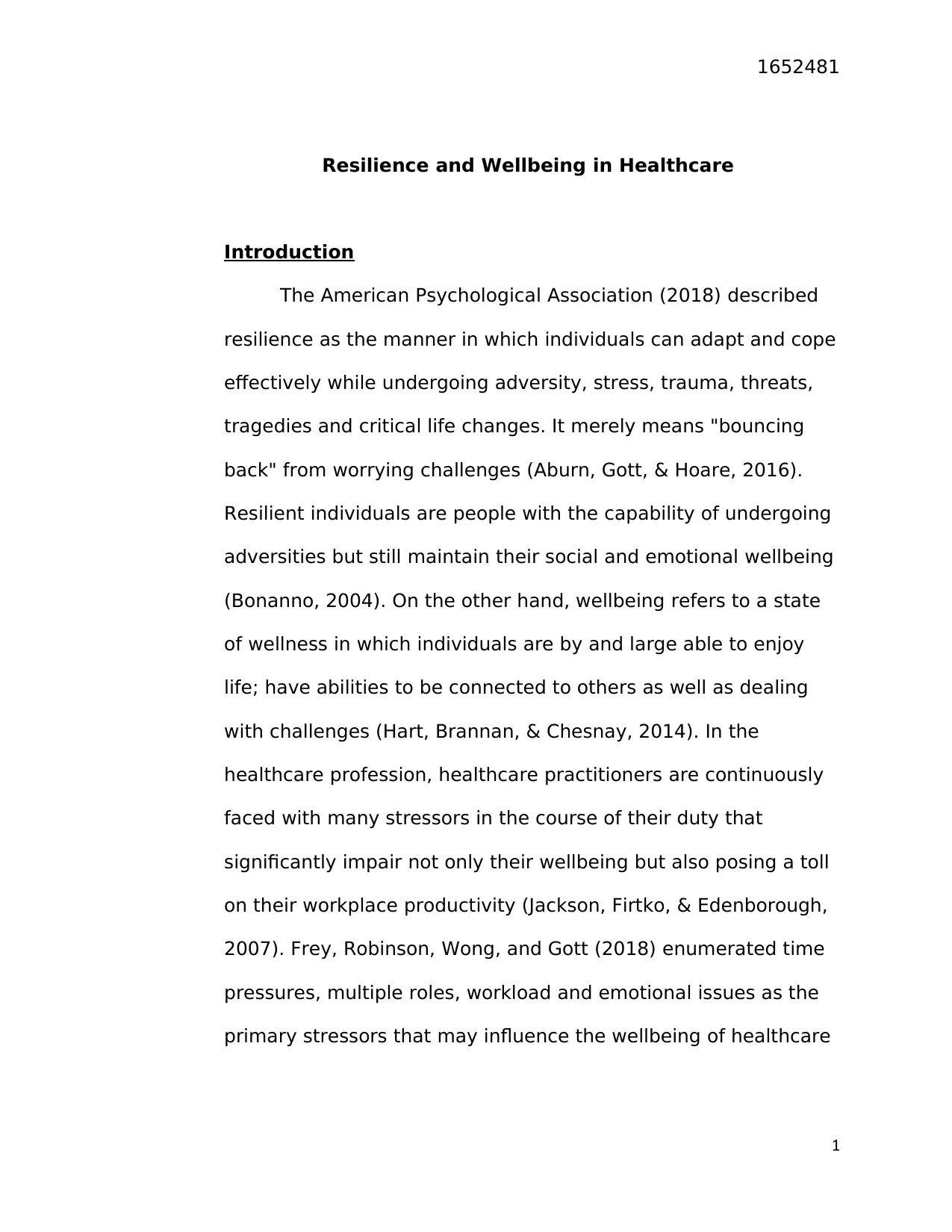
1652481
Resilience and Wellbeing in Healthcare
Introduction
The American Psychological Association (2018) described
resilience as the manner in which individuals can adapt and cope
effectively while undergoing adversity, stress, trauma, threats,
tragedies and critical life changes. It merely means "bouncing
back" from worrying challenges (Aburn, Gott, & Hoare, 2016).
Resilient individuals are people with the capability of undergoing
adversities but still maintain their social and emotional wellbeing
(Bonanno, 2004). On the other hand, wellbeing refers to a state
of wellness in which individuals are by and large able to enjoy
life; have abilities to be connected to others as well as dealing
with challenges (Hart, Brannan, & Chesnay, 2014). In the
healthcare profession, healthcare practitioners are continuously
faced with many stressors in the course of their duty that
significantly impair not only their wellbeing but also posing a toll
on their workplace productivity (Jackson, Firtko, & Edenborough,
2007). Frey, Robinson, Wong, and Gott (2018) enumerated time
pressures, multiple roles, workload and emotional issues as the
primary stressors that may influence the wellbeing of healthcare
1
Resilience and Wellbeing in Healthcare
Introduction
The American Psychological Association (2018) described
resilience as the manner in which individuals can adapt and cope
effectively while undergoing adversity, stress, trauma, threats,
tragedies and critical life changes. It merely means "bouncing
back" from worrying challenges (Aburn, Gott, & Hoare, 2016).
Resilient individuals are people with the capability of undergoing
adversities but still maintain their social and emotional wellbeing
(Bonanno, 2004). On the other hand, wellbeing refers to a state
of wellness in which individuals are by and large able to enjoy
life; have abilities to be connected to others as well as dealing
with challenges (Hart, Brannan, & Chesnay, 2014). In the
healthcare profession, healthcare practitioners are continuously
faced with many stressors in the course of their duty that
significantly impair not only their wellbeing but also posing a toll
on their workplace productivity (Jackson, Firtko, & Edenborough,
2007). Frey, Robinson, Wong, and Gott (2018) enumerated time
pressures, multiple roles, workload and emotional issues as the
primary stressors that may influence the wellbeing of healthcare
1
Paraphrase This Document
Need a fresh take? Get an instant paraphrase of this document with our AI Paraphraser
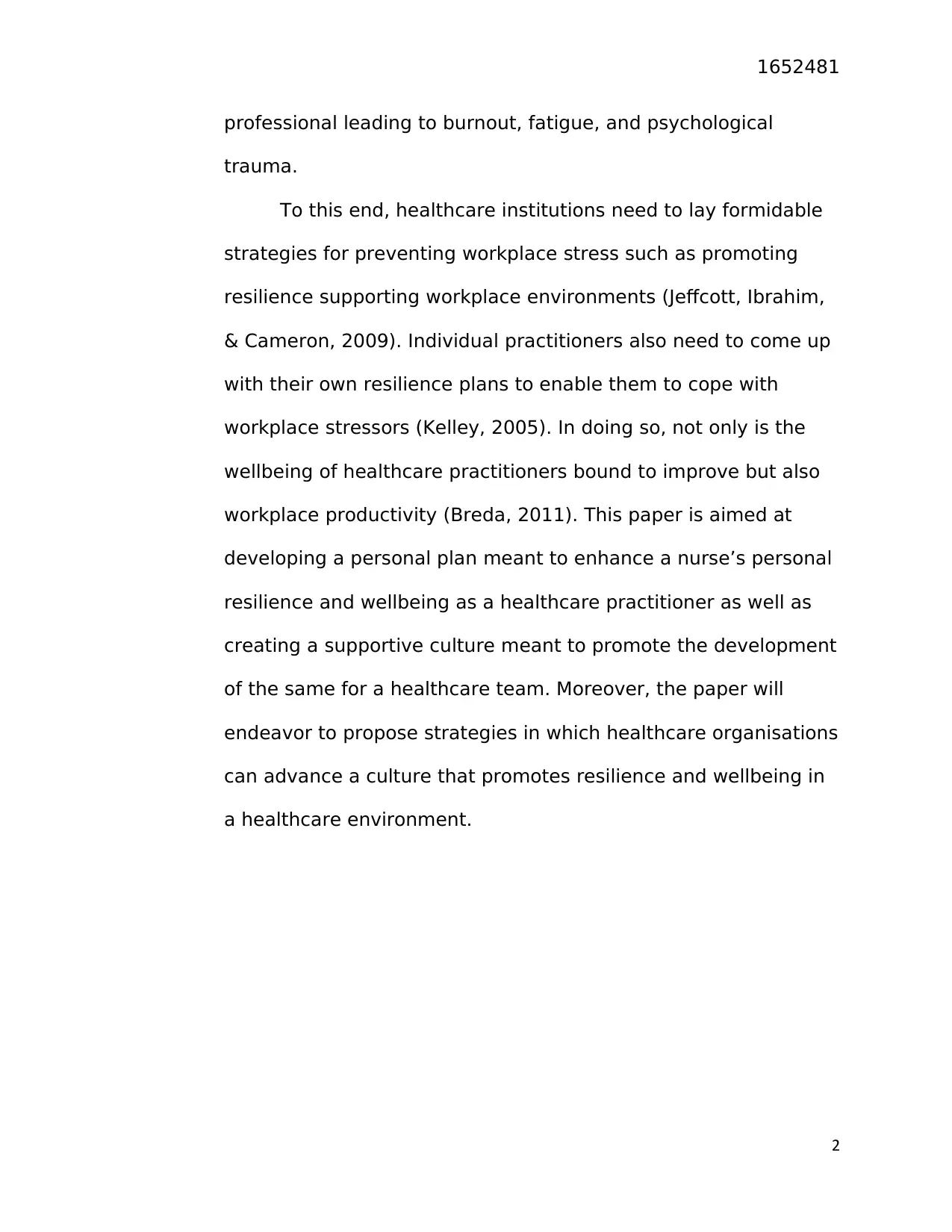
1652481
professional leading to burnout, fatigue, and psychological
trauma.
To this end, healthcare institutions need to lay formidable
strategies for preventing workplace stress such as promoting
resilience supporting workplace environments (Jeffcott, Ibrahim,
& Cameron, 2009). Individual practitioners also need to come up
with their own resilience plans to enable them to cope with
workplace stressors (Kelley, 2005). In doing so, not only is the
wellbeing of healthcare practitioners bound to improve but also
workplace productivity (Breda, 2011). This paper is aimed at
developing a personal plan meant to enhance a nurse’s personal
resilience and wellbeing as a healthcare practitioner as well as
creating a supportive culture meant to promote the development
of the same for a healthcare team. Moreover, the paper will
endeavor to propose strategies in which healthcare organisations
can advance a culture that promotes resilience and wellbeing in
a healthcare environment.
2
professional leading to burnout, fatigue, and psychological
trauma.
To this end, healthcare institutions need to lay formidable
strategies for preventing workplace stress such as promoting
resilience supporting workplace environments (Jeffcott, Ibrahim,
& Cameron, 2009). Individual practitioners also need to come up
with their own resilience plans to enable them to cope with
workplace stressors (Kelley, 2005). In doing so, not only is the
wellbeing of healthcare practitioners bound to improve but also
workplace productivity (Breda, 2011). This paper is aimed at
developing a personal plan meant to enhance a nurse’s personal
resilience and wellbeing as a healthcare practitioner as well as
creating a supportive culture meant to promote the development
of the same for a healthcare team. Moreover, the paper will
endeavor to propose strategies in which healthcare organisations
can advance a culture that promotes resilience and wellbeing in
a healthcare environment.
2
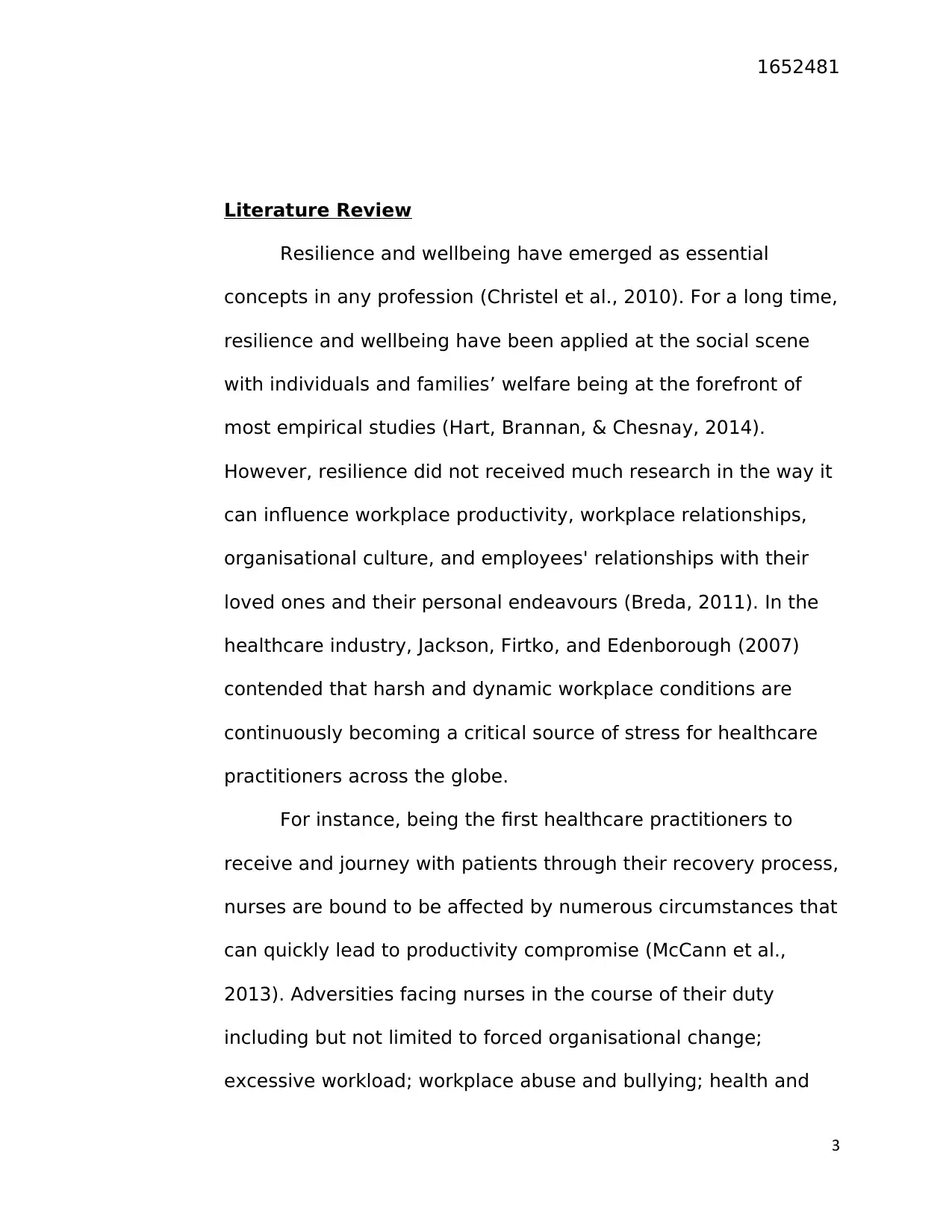
1652481
Literature Review
Resilience and wellbeing have emerged as essential
concepts in any profession (Christel et al., 2010). For a long time,
resilience and wellbeing have been applied at the social scene
with individuals and families’ welfare being at the forefront of
most empirical studies (Hart, Brannan, & Chesnay, 2014).
However, resilience did not received much research in the way it
can influence workplace productivity, workplace relationships,
organisational culture, and employees' relationships with their
loved ones and their personal endeavours (Breda, 2011). In the
healthcare industry, Jackson, Firtko, and Edenborough (2007)
contended that harsh and dynamic workplace conditions are
continuously becoming a critical source of stress for healthcare
practitioners across the globe.
For instance, being the first healthcare practitioners to
receive and journey with patients through their recovery process,
nurses are bound to be affected by numerous circumstances that
can quickly lead to productivity compromise (McCann et al.,
2013). Adversities facing nurses in the course of their duty
including but not limited to forced organisational change;
excessive workload; workplace abuse and bullying; health and
3
Literature Review
Resilience and wellbeing have emerged as essential
concepts in any profession (Christel et al., 2010). For a long time,
resilience and wellbeing have been applied at the social scene
with individuals and families’ welfare being at the forefront of
most empirical studies (Hart, Brannan, & Chesnay, 2014).
However, resilience did not received much research in the way it
can influence workplace productivity, workplace relationships,
organisational culture, and employees' relationships with their
loved ones and their personal endeavours (Breda, 2011). In the
healthcare industry, Jackson, Firtko, and Edenborough (2007)
contended that harsh and dynamic workplace conditions are
continuously becoming a critical source of stress for healthcare
practitioners across the globe.
For instance, being the first healthcare practitioners to
receive and journey with patients through their recovery process,
nurses are bound to be affected by numerous circumstances that
can quickly lead to productivity compromise (McCann et al.,
2013). Adversities facing nurses in the course of their duty
including but not limited to forced organisational change;
excessive workload; workplace abuse and bullying; health and
3
⊘ This is a preview!⊘
Do you want full access?
Subscribe today to unlock all pages.

Trusted by 1+ million students worldwide
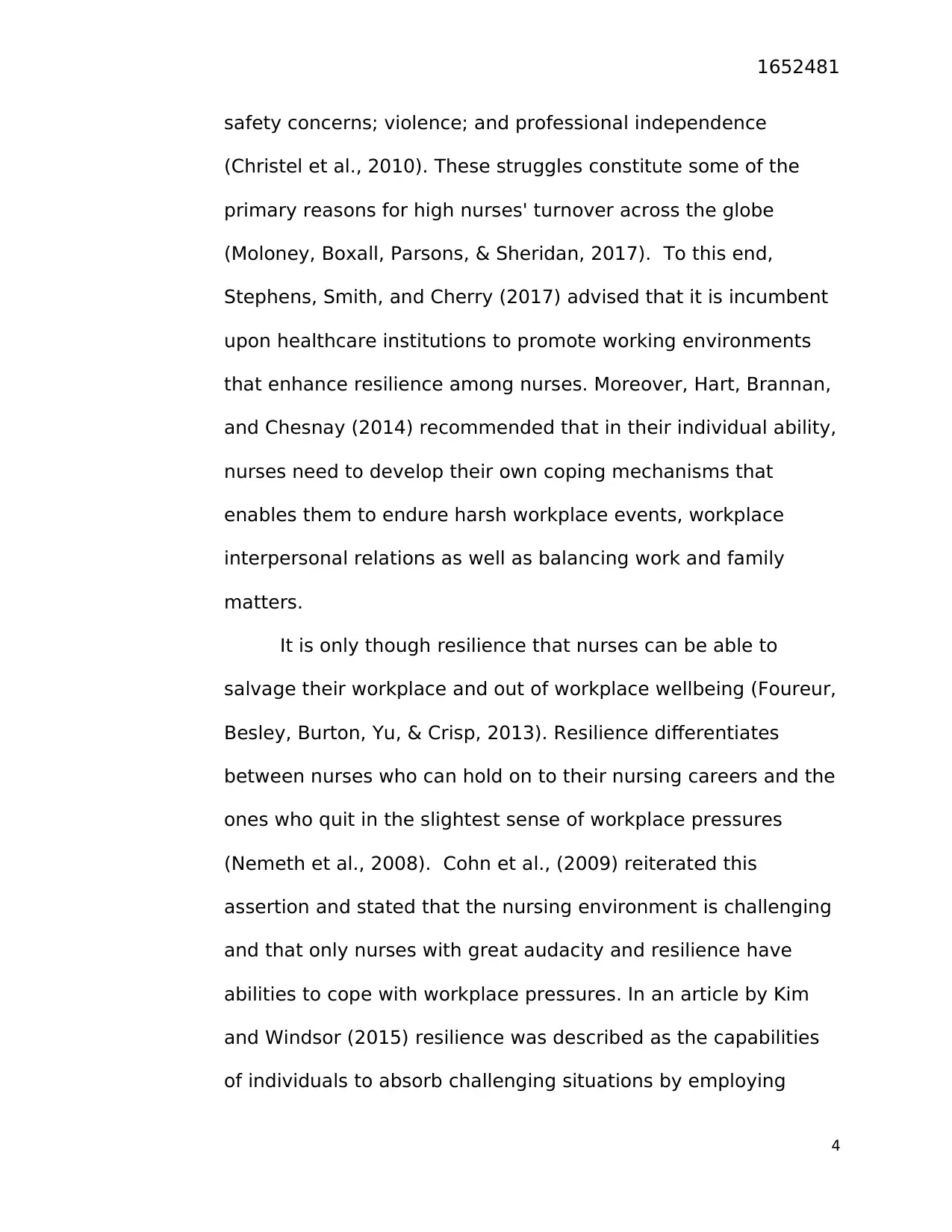
1652481
safety concerns; violence; and professional independence
(Christel et al., 2010). These struggles constitute some of the
primary reasons for high nurses' turnover across the globe
(Moloney, Boxall, Parsons, & Sheridan, 2017). To this end,
Stephens, Smith, and Cherry (2017) advised that it is incumbent
upon healthcare institutions to promote working environments
that enhance resilience among nurses. Moreover, Hart, Brannan,
and Chesnay (2014) recommended that in their individual ability,
nurses need to develop their own coping mechanisms that
enables them to endure harsh workplace events, workplace
interpersonal relations as well as balancing work and family
matters.
It is only though resilience that nurses can be able to
salvage their workplace and out of workplace wellbeing (Foureur,
Besley, Burton, Yu, & Crisp, 2013). Resilience differentiates
between nurses who can hold on to their nursing careers and the
ones who quit in the slightest sense of workplace pressures
(Nemeth et al., 2008). Cohn et al., (2009) reiterated this
assertion and stated that the nursing environment is challenging
and that only nurses with great audacity and resilience have
abilities to cope with workplace pressures. In an article by Kim
and Windsor (2015) resilience was described as the capabilities
of individuals to absorb challenging situations by employing
4
safety concerns; violence; and professional independence
(Christel et al., 2010). These struggles constitute some of the
primary reasons for high nurses' turnover across the globe
(Moloney, Boxall, Parsons, & Sheridan, 2017). To this end,
Stephens, Smith, and Cherry (2017) advised that it is incumbent
upon healthcare institutions to promote working environments
that enhance resilience among nurses. Moreover, Hart, Brannan,
and Chesnay (2014) recommended that in their individual ability,
nurses need to develop their own coping mechanisms that
enables them to endure harsh workplace events, workplace
interpersonal relations as well as balancing work and family
matters.
It is only though resilience that nurses can be able to
salvage their workplace and out of workplace wellbeing (Foureur,
Besley, Burton, Yu, & Crisp, 2013). Resilience differentiates
between nurses who can hold on to their nursing careers and the
ones who quit in the slightest sense of workplace pressures
(Nemeth et al., 2008). Cohn et al., (2009) reiterated this
assertion and stated that the nursing environment is challenging
and that only nurses with great audacity and resilience have
abilities to cope with workplace pressures. In an article by Kim
and Windsor (2015) resilience was described as the capabilities
of individuals to absorb challenging situations by employing
4
Paraphrase This Document
Need a fresh take? Get an instant paraphrase of this document with our AI Paraphraser
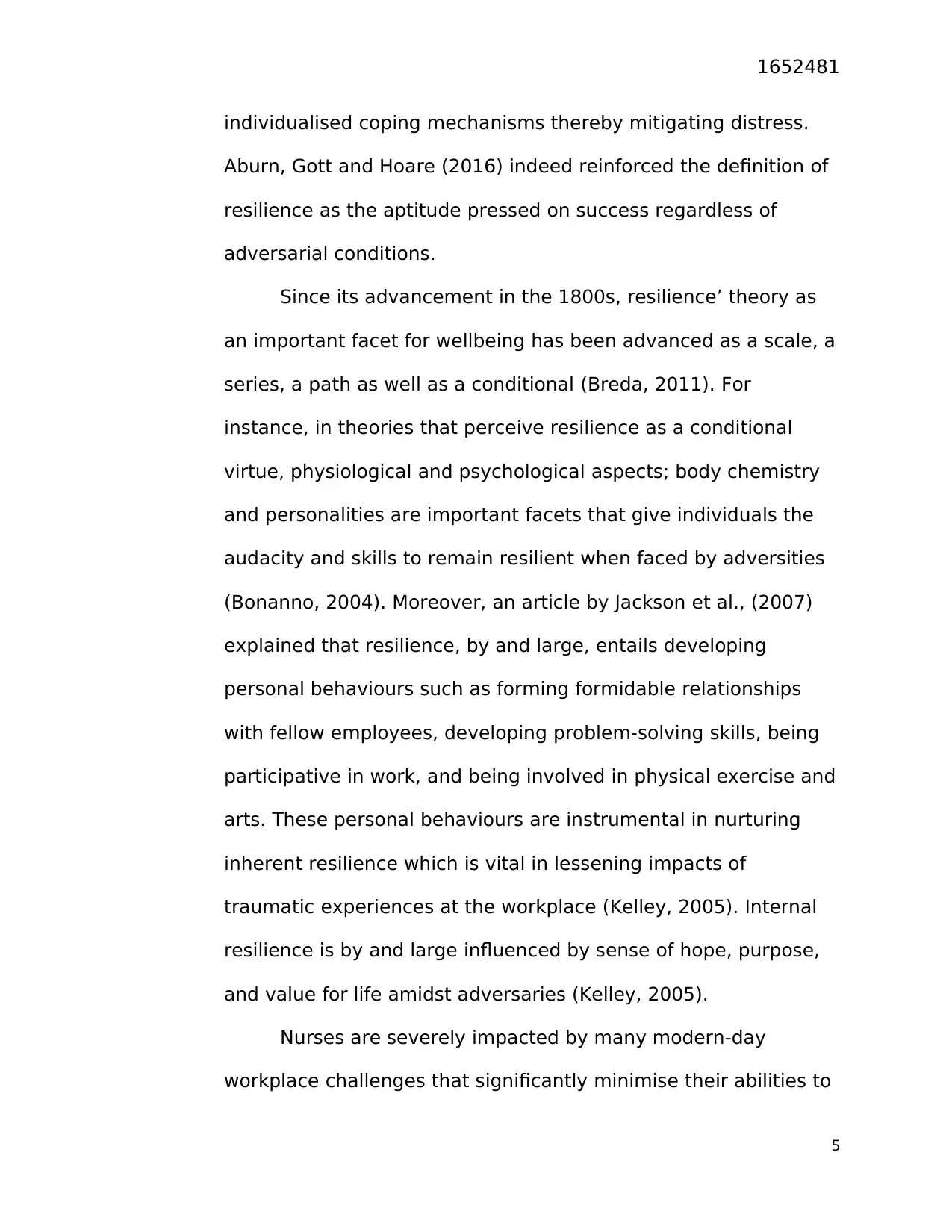
1652481
individualised coping mechanisms thereby mitigating distress.
Aburn, Gott and Hoare (2016) indeed reinforced the definition of
resilience as the aptitude pressed on success regardless of
adversarial conditions.
Since its advancement in the 1800s, resilience’ theory as
an important facet for wellbeing has been advanced as a scale, a
series, a path as well as a conditional (Breda, 2011). For
instance, in theories that perceive resilience as a conditional
virtue, physiological and psychological aspects; body chemistry
and personalities are important facets that give individuals the
audacity and skills to remain resilient when faced by adversities
(Bonanno, 2004). Moreover, an article by Jackson et al., (2007)
explained that resilience, by and large, entails developing
personal behaviours such as forming formidable relationships
with fellow employees, developing problem-solving skills, being
participative in work, and being involved in physical exercise and
arts. These personal behaviours are instrumental in nurturing
inherent resilience which is vital in lessening impacts of
traumatic experiences at the workplace (Kelley, 2005). Internal
resilience is by and large influenced by sense of hope, purpose,
and value for life amidst adversaries (Kelley, 2005).
Nurses are severely impacted by many modern-day
workplace challenges that significantly minimise their abilities to
5
individualised coping mechanisms thereby mitigating distress.
Aburn, Gott and Hoare (2016) indeed reinforced the definition of
resilience as the aptitude pressed on success regardless of
adversarial conditions.
Since its advancement in the 1800s, resilience’ theory as
an important facet for wellbeing has been advanced as a scale, a
series, a path as well as a conditional (Breda, 2011). For
instance, in theories that perceive resilience as a conditional
virtue, physiological and psychological aspects; body chemistry
and personalities are important facets that give individuals the
audacity and skills to remain resilient when faced by adversities
(Bonanno, 2004). Moreover, an article by Jackson et al., (2007)
explained that resilience, by and large, entails developing
personal behaviours such as forming formidable relationships
with fellow employees, developing problem-solving skills, being
participative in work, and being involved in physical exercise and
arts. These personal behaviours are instrumental in nurturing
inherent resilience which is vital in lessening impacts of
traumatic experiences at the workplace (Kelley, 2005). Internal
resilience is by and large influenced by sense of hope, purpose,
and value for life amidst adversaries (Kelley, 2005).
Nurses are severely impacted by many modern-day
workplace challenges that significantly minimise their abilities to
5
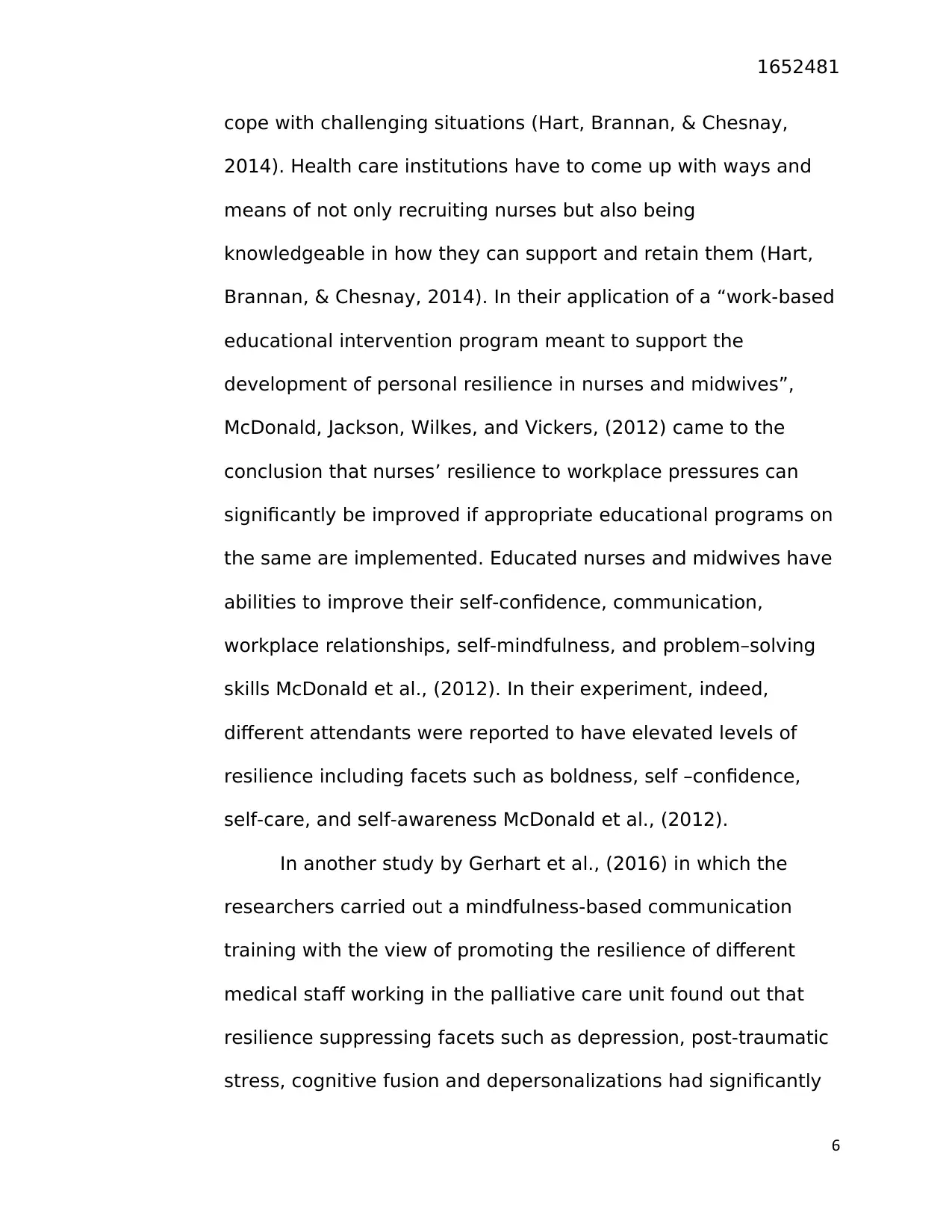
1652481
cope with challenging situations (Hart, Brannan, & Chesnay,
2014). Health care institutions have to come up with ways and
means of not only recruiting nurses but also being
knowledgeable in how they can support and retain them (Hart,
Brannan, & Chesnay, 2014). In their application of a “work-based
educational intervention program meant to support the
development of personal resilience in nurses and midwives”,
McDonald, Jackson, Wilkes, and Vickers, (2012) came to the
conclusion that nurses’ resilience to workplace pressures can
significantly be improved if appropriate educational programs on
the same are implemented. Educated nurses and midwives have
abilities to improve their self-confidence, communication,
workplace relationships, self-mindfulness, and problem–solving
skills McDonald et al., (2012). In their experiment, indeed,
different attendants were reported to have elevated levels of
resilience including facets such as boldness, self –confidence,
self-care, and self-awareness McDonald et al., (2012).
In another study by Gerhart et al., (2016) in which the
researchers carried out a mindfulness-based communication
training with the view of promoting the resilience of different
medical staff working in the palliative care unit found out that
resilience suppressing facets such as depression, post-traumatic
stress, cognitive fusion and depersonalizations had significantly
6
cope with challenging situations (Hart, Brannan, & Chesnay,
2014). Health care institutions have to come up with ways and
means of not only recruiting nurses but also being
knowledgeable in how they can support and retain them (Hart,
Brannan, & Chesnay, 2014). In their application of a “work-based
educational intervention program meant to support the
development of personal resilience in nurses and midwives”,
McDonald, Jackson, Wilkes, and Vickers, (2012) came to the
conclusion that nurses’ resilience to workplace pressures can
significantly be improved if appropriate educational programs on
the same are implemented. Educated nurses and midwives have
abilities to improve their self-confidence, communication,
workplace relationships, self-mindfulness, and problem–solving
skills McDonald et al., (2012). In their experiment, indeed,
different attendants were reported to have elevated levels of
resilience including facets such as boldness, self –confidence,
self-care, and self-awareness McDonald et al., (2012).
In another study by Gerhart et al., (2016) in which the
researchers carried out a mindfulness-based communication
training with the view of promoting the resilience of different
medical staff working in the palliative care unit found out that
resilience suppressing facets such as depression, post-traumatic
stress, cognitive fusion and depersonalizations had significantly
6
⊘ This is a preview!⊘
Do you want full access?
Subscribe today to unlock all pages.

Trusted by 1+ million students worldwide
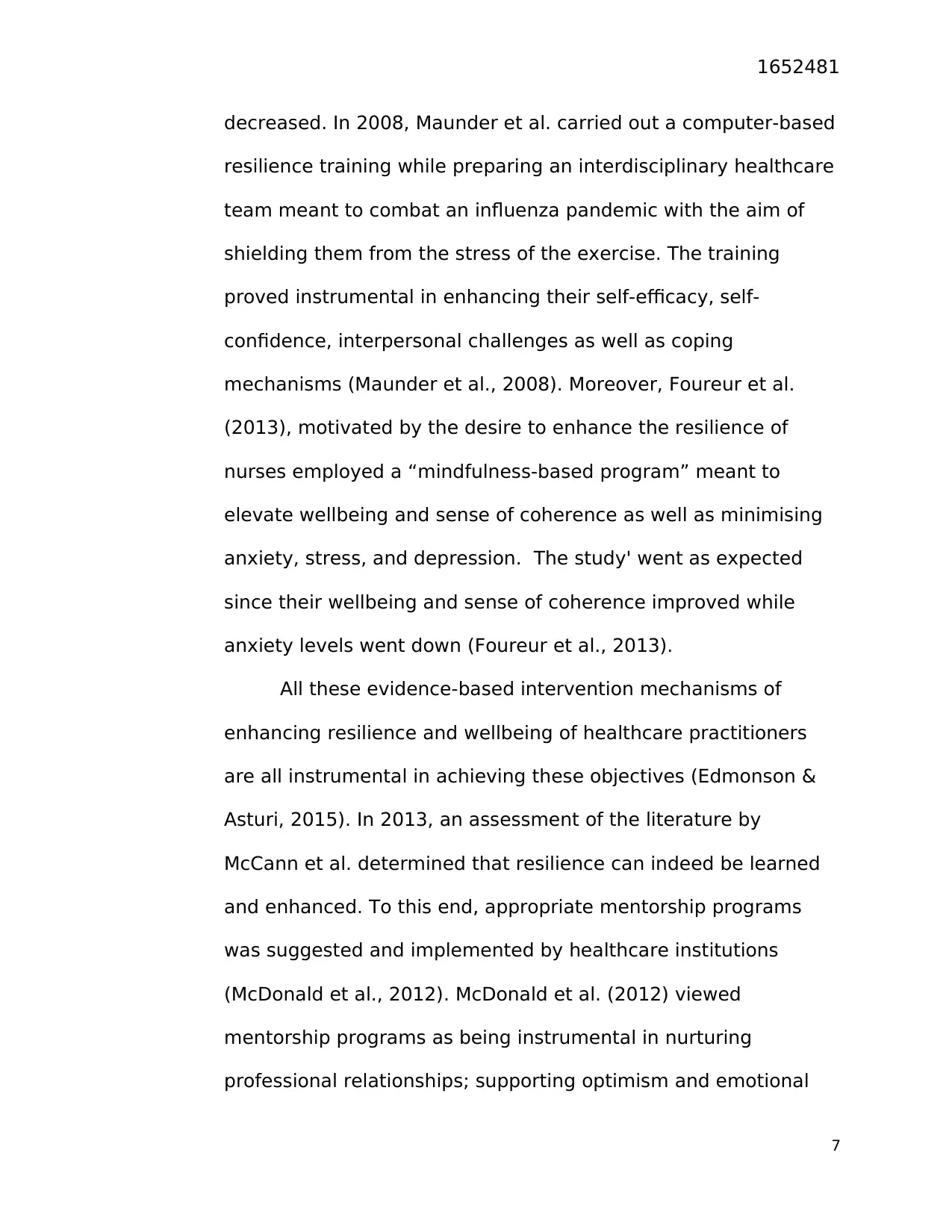
1652481
decreased. In 2008, Maunder et al. carried out a computer-based
resilience training while preparing an interdisciplinary healthcare
team meant to combat an influenza pandemic with the aim of
shielding them from the stress of the exercise. The training
proved instrumental in enhancing their self-efficacy, self-
confidence, interpersonal challenges as well as coping
mechanisms (Maunder et al., 2008). Moreover, Foureur et al.
(2013), motivated by the desire to enhance the resilience of
nurses employed a “mindfulness-based program” meant to
elevate wellbeing and sense of coherence as well as minimising
anxiety, stress, and depression. The study' went as expected
since their wellbeing and sense of coherence improved while
anxiety levels went down (Foureur et al., 2013).
All these evidence-based intervention mechanisms of
enhancing resilience and wellbeing of healthcare practitioners
are all instrumental in achieving these objectives (Edmonson &
Asturi, 2015). In 2013, an assessment of the literature by
McCann et al. determined that resilience can indeed be learned
and enhanced. To this end, appropriate mentorship programs
was suggested and implemented by healthcare institutions
(McDonald et al., 2012). McDonald et al. (2012) viewed
mentorship programs as being instrumental in nurturing
professional relationships; supporting optimism and emotional
7
decreased. In 2008, Maunder et al. carried out a computer-based
resilience training while preparing an interdisciplinary healthcare
team meant to combat an influenza pandemic with the aim of
shielding them from the stress of the exercise. The training
proved instrumental in enhancing their self-efficacy, self-
confidence, interpersonal challenges as well as coping
mechanisms (Maunder et al., 2008). Moreover, Foureur et al.
(2013), motivated by the desire to enhance the resilience of
nurses employed a “mindfulness-based program” meant to
elevate wellbeing and sense of coherence as well as minimising
anxiety, stress, and depression. The study' went as expected
since their wellbeing and sense of coherence improved while
anxiety levels went down (Foureur et al., 2013).
All these evidence-based intervention mechanisms of
enhancing resilience and wellbeing of healthcare practitioners
are all instrumental in achieving these objectives (Edmonson &
Asturi, 2015). In 2013, an assessment of the literature by
McCann et al. determined that resilience can indeed be learned
and enhanced. To this end, appropriate mentorship programs
was suggested and implemented by healthcare institutions
(McDonald et al., 2012). McDonald et al. (2012) viewed
mentorship programs as being instrumental in nurturing
professional relationships; supporting optimism and emotional
7
Paraphrase This Document
Need a fresh take? Get an instant paraphrase of this document with our AI Paraphraser
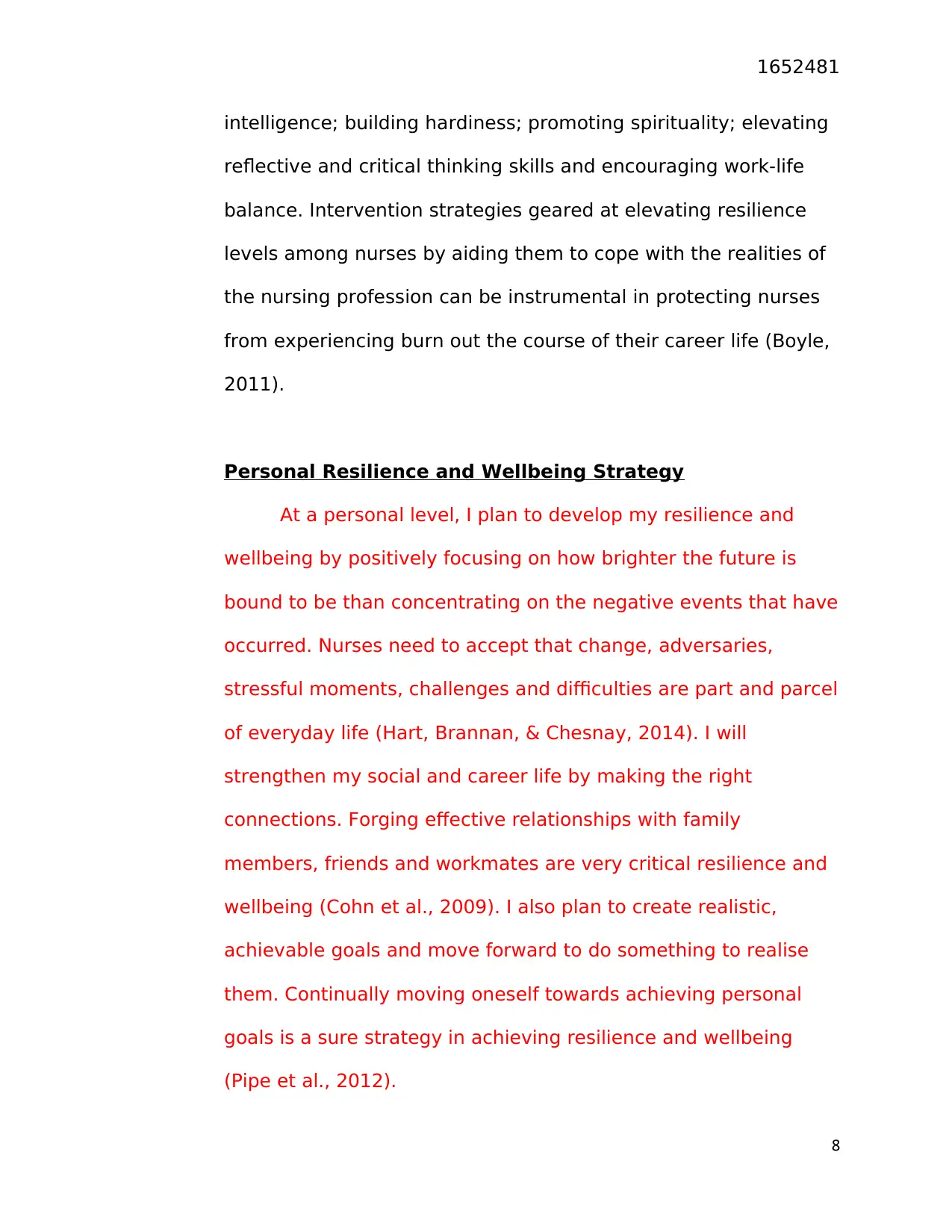
1652481
intelligence; building hardiness; promoting spirituality; elevating
reflective and critical thinking skills and encouraging work-life
balance. Intervention strategies geared at elevating resilience
levels among nurses by aiding them to cope with the realities of
the nursing profession can be instrumental in protecting nurses
from experiencing burn out the course of their career life (Boyle,
2011).
Personal Resilience and Wellbeing Strategy
At a personal level, I plan to develop my resilience and
wellbeing by positively focusing on how brighter the future is
bound to be than concentrating on the negative events that have
occurred. Nurses need to accept that change, adversaries,
stressful moments, challenges and difficulties are part and parcel
of everyday life (Hart, Brannan, & Chesnay, 2014). I will
strengthen my social and career life by making the right
connections. Forging effective relationships with family
members, friends and workmates are very critical resilience and
wellbeing (Cohn et al., 2009). I also plan to create realistic,
achievable goals and move forward to do something to realise
them. Continually moving oneself towards achieving personal
goals is a sure strategy in achieving resilience and wellbeing
(Pipe et al., 2012).
8
intelligence; building hardiness; promoting spirituality; elevating
reflective and critical thinking skills and encouraging work-life
balance. Intervention strategies geared at elevating resilience
levels among nurses by aiding them to cope with the realities of
the nursing profession can be instrumental in protecting nurses
from experiencing burn out the course of their career life (Boyle,
2011).
Personal Resilience and Wellbeing Strategy
At a personal level, I plan to develop my resilience and
wellbeing by positively focusing on how brighter the future is
bound to be than concentrating on the negative events that have
occurred. Nurses need to accept that change, adversaries,
stressful moments, challenges and difficulties are part and parcel
of everyday life (Hart, Brannan, & Chesnay, 2014). I will
strengthen my social and career life by making the right
connections. Forging effective relationships with family
members, friends and workmates are very critical resilience and
wellbeing (Cohn et al., 2009). I also plan to create realistic,
achievable goals and move forward to do something to realise
them. Continually moving oneself towards achieving personal
goals is a sure strategy in achieving resilience and wellbeing
(Pipe et al., 2012).
8
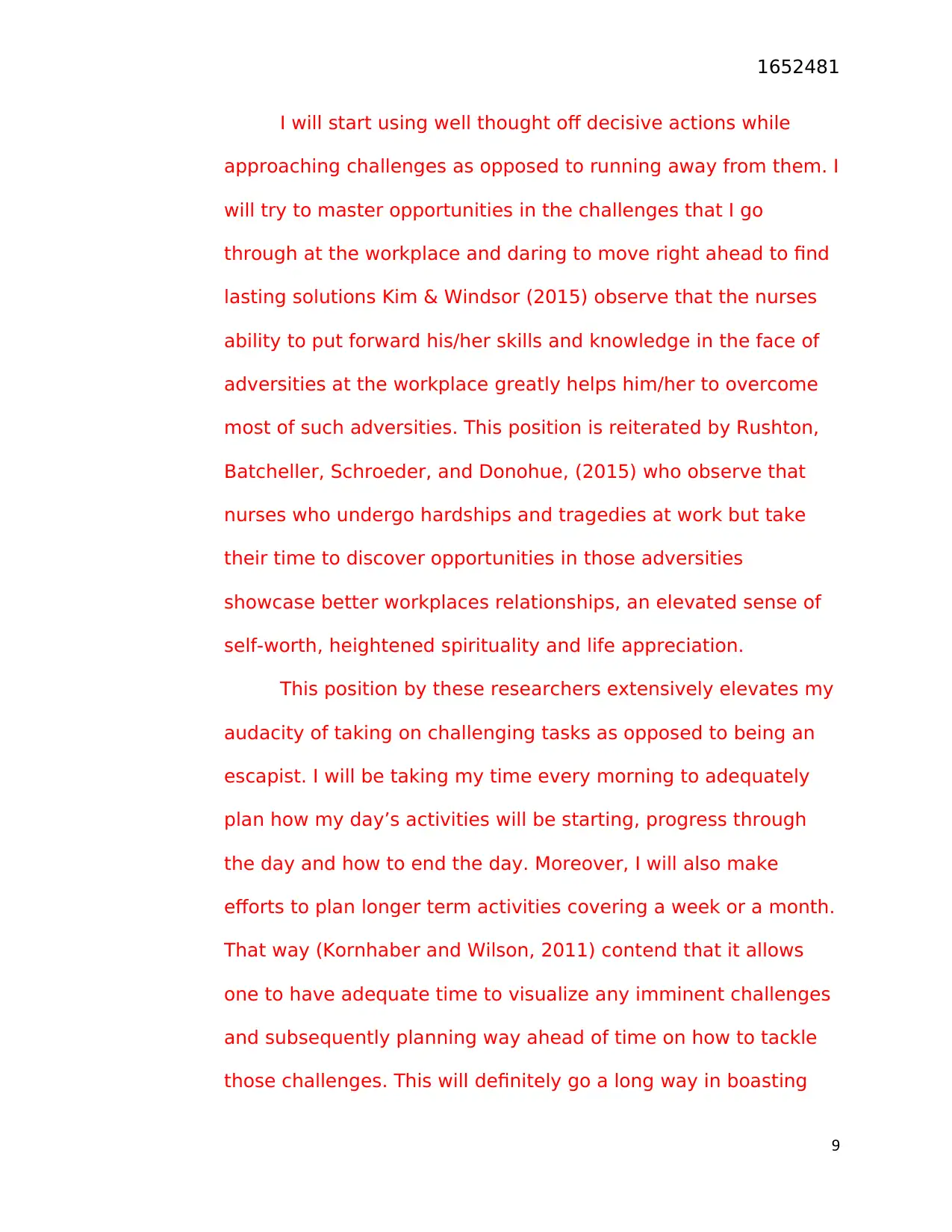
1652481
I will start using well thought off decisive actions while
approaching challenges as opposed to running away from them. I
will try to master opportunities in the challenges that I go
through at the workplace and daring to move right ahead to find
lasting solutions Kim & Windsor (2015) observe that the nurses
ability to put forward his/her skills and knowledge in the face of
adversities at the workplace greatly helps him/her to overcome
most of such adversities. This position is reiterated by Rushton,
Batcheller, Schroeder, and Donohue, (2015) who observe that
nurses who undergo hardships and tragedies at work but take
their time to discover opportunities in those adversities
showcase better workplaces relationships, an elevated sense of
self-worth, heightened spirituality and life appreciation.
This position by these researchers extensively elevates my
audacity of taking on challenging tasks as opposed to being an
escapist. I will be taking my time every morning to adequately
plan how my day’s activities will be starting, progress through
the day and how to end the day. Moreover, I will also make
efforts to plan longer term activities covering a week or a month.
That way (Kornhaber and Wilson, 2011) contend that it allows
one to have adequate time to visualize any imminent challenges
and subsequently planning way ahead of time on how to tackle
those challenges. This will definitely go a long way in boasting
9
I will start using well thought off decisive actions while
approaching challenges as opposed to running away from them. I
will try to master opportunities in the challenges that I go
through at the workplace and daring to move right ahead to find
lasting solutions Kim & Windsor (2015) observe that the nurses
ability to put forward his/her skills and knowledge in the face of
adversities at the workplace greatly helps him/her to overcome
most of such adversities. This position is reiterated by Rushton,
Batcheller, Schroeder, and Donohue, (2015) who observe that
nurses who undergo hardships and tragedies at work but take
their time to discover opportunities in those adversities
showcase better workplaces relationships, an elevated sense of
self-worth, heightened spirituality and life appreciation.
This position by these researchers extensively elevates my
audacity of taking on challenging tasks as opposed to being an
escapist. I will be taking my time every morning to adequately
plan how my day’s activities will be starting, progress through
the day and how to end the day. Moreover, I will also make
efforts to plan longer term activities covering a week or a month.
That way (Kornhaber and Wilson, 2011) contend that it allows
one to have adequate time to visualize any imminent challenges
and subsequently planning way ahead of time on how to tackle
those challenges. This will definitely go a long way in boasting
9
⊘ This is a preview!⊘
Do you want full access?
Subscribe today to unlock all pages.

Trusted by 1+ million students worldwide
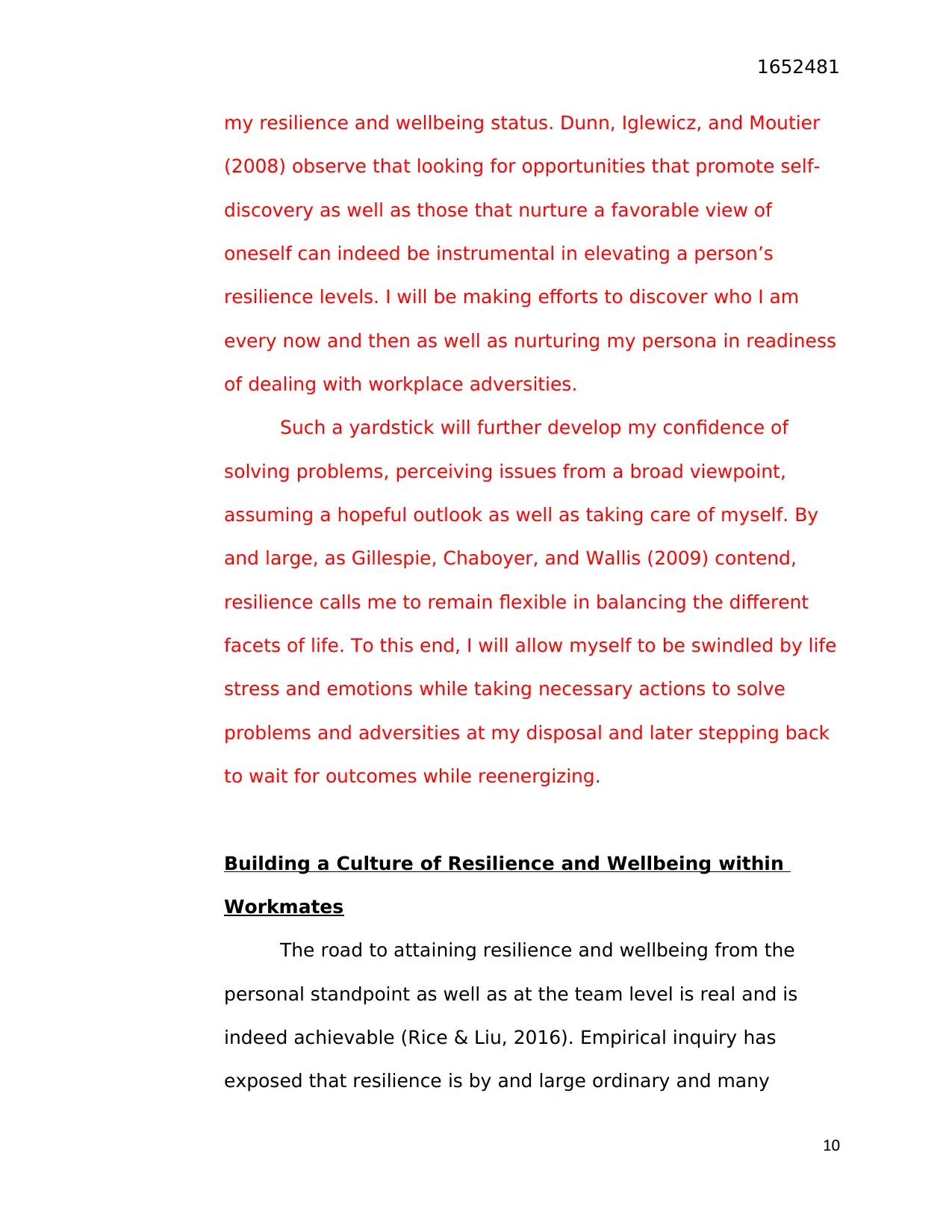
1652481
my resilience and wellbeing status. Dunn, Iglewicz, and Moutier
(2008) observe that looking for opportunities that promote self-
discovery as well as those that nurture a favorable view of
oneself can indeed be instrumental in elevating a person’s
resilience levels. I will be making efforts to discover who I am
every now and then as well as nurturing my persona in readiness
of dealing with workplace adversities.
Such a yardstick will further develop my confidence of
solving problems, perceiving issues from a broad viewpoint,
assuming a hopeful outlook as well as taking care of myself. By
and large, as Gillespie, Chaboyer, and Wallis (2009) contend,
resilience calls me to remain flexible in balancing the different
facets of life. To this end, I will allow myself to be swindled by life
stress and emotions while taking necessary actions to solve
problems and adversities at my disposal and later stepping back
to wait for outcomes while reenergizing.
Building a Culture of Resilience and Wellbeing within
Workmates
The road to attaining resilience and wellbeing from the
personal standpoint as well as at the team level is real and is
indeed achievable (Rice & Liu, 2016). Empirical inquiry has
exposed that resilience is by and large ordinary and many
10
my resilience and wellbeing status. Dunn, Iglewicz, and Moutier
(2008) observe that looking for opportunities that promote self-
discovery as well as those that nurture a favorable view of
oneself can indeed be instrumental in elevating a person’s
resilience levels. I will be making efforts to discover who I am
every now and then as well as nurturing my persona in readiness
of dealing with workplace adversities.
Such a yardstick will further develop my confidence of
solving problems, perceiving issues from a broad viewpoint,
assuming a hopeful outlook as well as taking care of myself. By
and large, as Gillespie, Chaboyer, and Wallis (2009) contend,
resilience calls me to remain flexible in balancing the different
facets of life. To this end, I will allow myself to be swindled by life
stress and emotions while taking necessary actions to solve
problems and adversities at my disposal and later stepping back
to wait for outcomes while reenergizing.
Building a Culture of Resilience and Wellbeing within
Workmates
The road to attaining resilience and wellbeing from the
personal standpoint as well as at the team level is real and is
indeed achievable (Rice & Liu, 2016). Empirical inquiry has
exposed that resilience is by and large ordinary and many
10
Paraphrase This Document
Need a fresh take? Get an instant paraphrase of this document with our AI Paraphraser
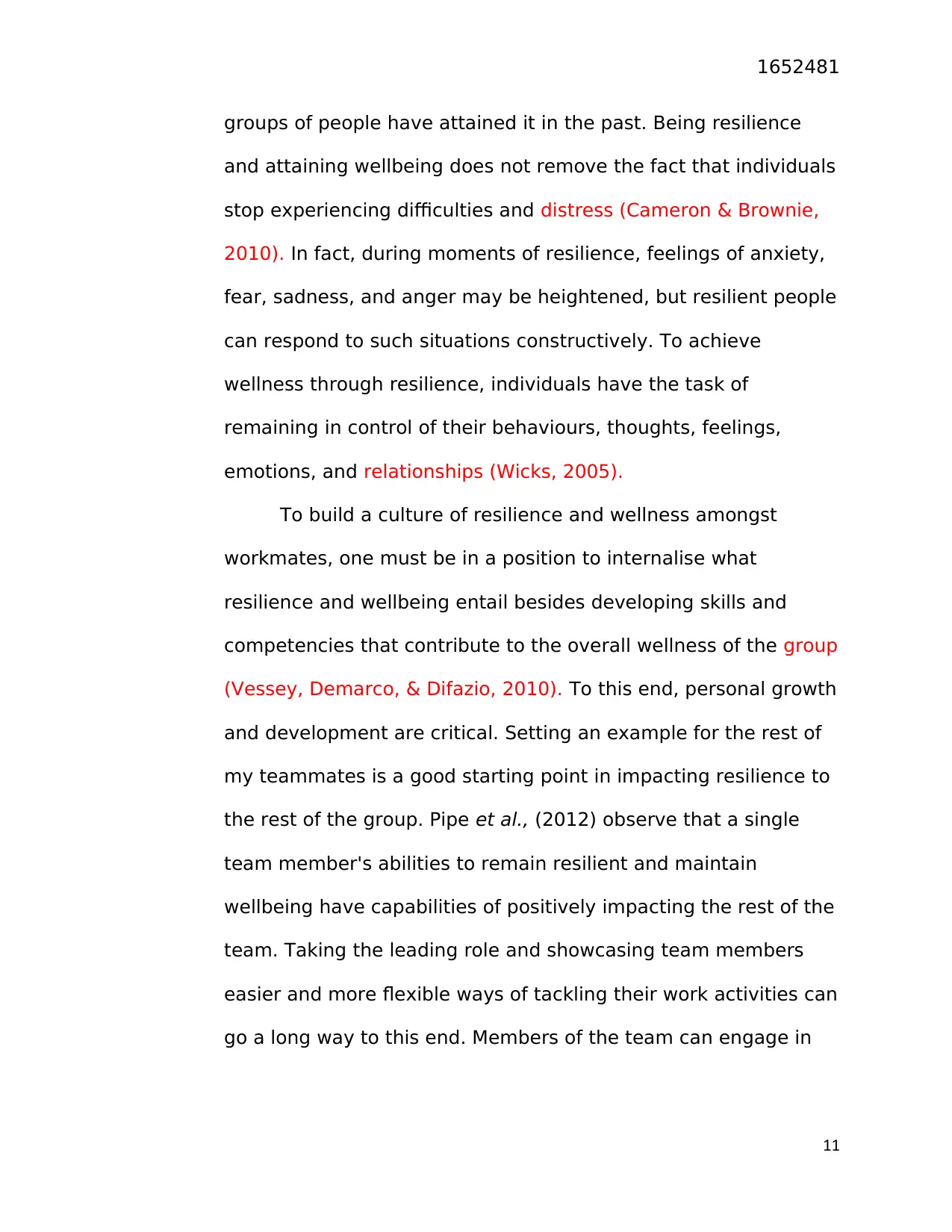
1652481
groups of people have attained it in the past. Being resilience
and attaining wellbeing does not remove the fact that individuals
stop experiencing difficulties and distress (Cameron & Brownie,
2010). In fact, during moments of resilience, feelings of anxiety,
fear, sadness, and anger may be heightened, but resilient people
can respond to such situations constructively. To achieve
wellness through resilience, individuals have the task of
remaining in control of their behaviours, thoughts, feelings,
emotions, and relationships (Wicks, 2005).
To build a culture of resilience and wellness amongst
workmates, one must be in a position to internalise what
resilience and wellbeing entail besides developing skills and
competencies that contribute to the overall wellness of the group
(Vessey, Demarco, & Difazio, 2010). To this end, personal growth
and development are critical. Setting an example for the rest of
my teammates is a good starting point in impacting resilience to
the rest of the group. Pipe et al., (2012) observe that a single
team member's abilities to remain resilient and maintain
wellbeing have capabilities of positively impacting the rest of the
team. Taking the leading role and showcasing team members
easier and more flexible ways of tackling their work activities can
go a long way to this end. Members of the team can engage in
11
groups of people have attained it in the past. Being resilience
and attaining wellbeing does not remove the fact that individuals
stop experiencing difficulties and distress (Cameron & Brownie,
2010). In fact, during moments of resilience, feelings of anxiety,
fear, sadness, and anger may be heightened, but resilient people
can respond to such situations constructively. To achieve
wellness through resilience, individuals have the task of
remaining in control of their behaviours, thoughts, feelings,
emotions, and relationships (Wicks, 2005).
To build a culture of resilience and wellness amongst
workmates, one must be in a position to internalise what
resilience and wellbeing entail besides developing skills and
competencies that contribute to the overall wellness of the group
(Vessey, Demarco, & Difazio, 2010). To this end, personal growth
and development are critical. Setting an example for the rest of
my teammates is a good starting point in impacting resilience to
the rest of the group. Pipe et al., (2012) observe that a single
team member's abilities to remain resilient and maintain
wellbeing have capabilities of positively impacting the rest of the
team. Taking the leading role and showcasing team members
easier and more flexible ways of tackling their work activities can
go a long way to this end. Members of the team can engage in
11
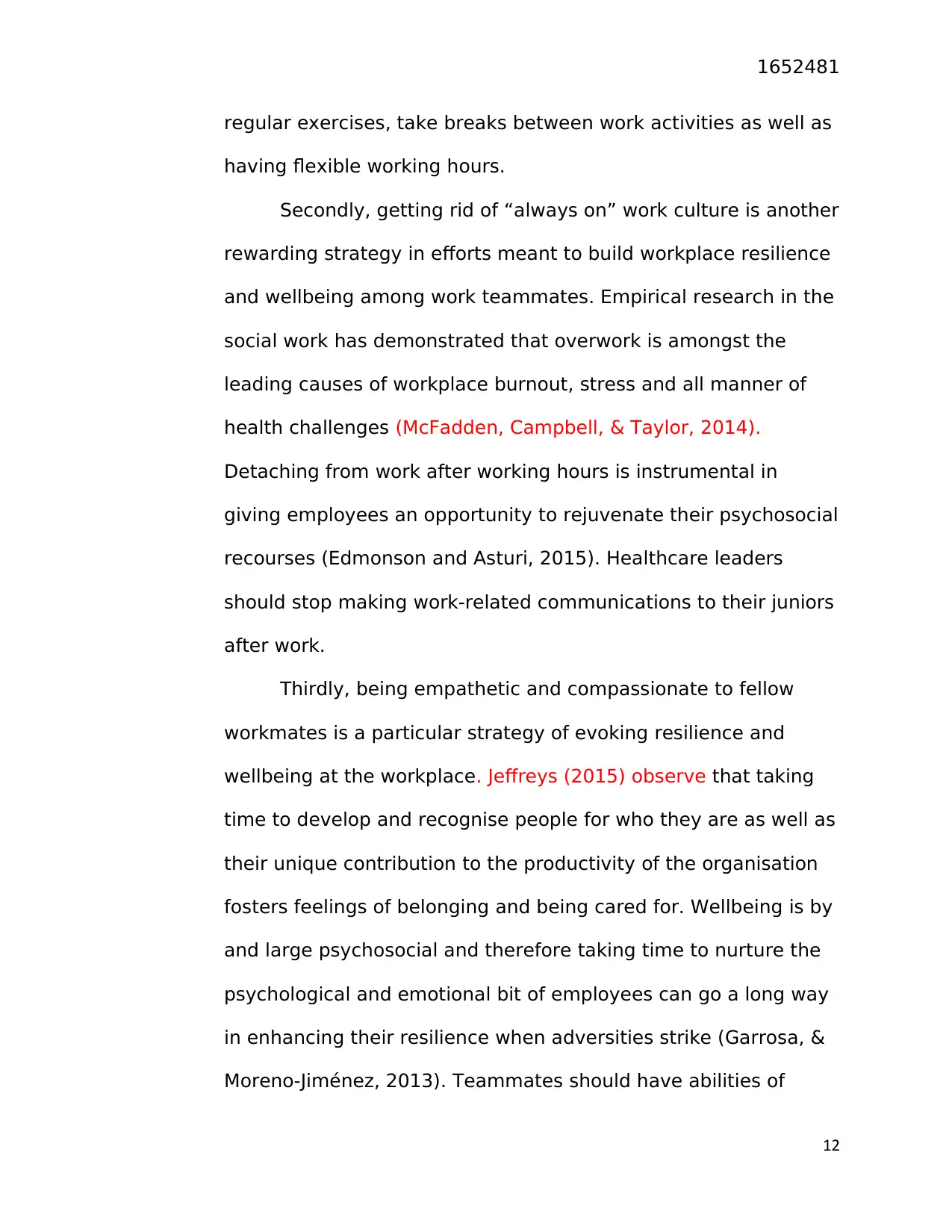
1652481
regular exercises, take breaks between work activities as well as
having flexible working hours.
Secondly, getting rid of “always on” work culture is another
rewarding strategy in efforts meant to build workplace resilience
and wellbeing among work teammates. Empirical research in the
social work has demonstrated that overwork is amongst the
leading causes of workplace burnout, stress and all manner of
health challenges (McFadden, Campbell, & Taylor, 2014).
Detaching from work after working hours is instrumental in
giving employees an opportunity to rejuvenate their psychosocial
recourses (Edmonson and Asturi, 2015). Healthcare leaders
should stop making work-related communications to their juniors
after work.
Thirdly, being empathetic and compassionate to fellow
workmates is a particular strategy of evoking resilience and
wellbeing at the workplace. Jeffreys (2015) observe that taking
time to develop and recognise people for who they are as well as
their unique contribution to the productivity of the organisation
fosters feelings of belonging and being cared for. Wellbeing is by
and large psychosocial and therefore taking time to nurture the
psychological and emotional bit of employees can go a long way
in enhancing their resilience when adversities strike (Garrosa, &
Moreno-Jiménez, 2013). Teammates should have abilities of
12
regular exercises, take breaks between work activities as well as
having flexible working hours.
Secondly, getting rid of “always on” work culture is another
rewarding strategy in efforts meant to build workplace resilience
and wellbeing among work teammates. Empirical research in the
social work has demonstrated that overwork is amongst the
leading causes of workplace burnout, stress and all manner of
health challenges (McFadden, Campbell, & Taylor, 2014).
Detaching from work after working hours is instrumental in
giving employees an opportunity to rejuvenate their psychosocial
recourses (Edmonson and Asturi, 2015). Healthcare leaders
should stop making work-related communications to their juniors
after work.
Thirdly, being empathetic and compassionate to fellow
workmates is a particular strategy of evoking resilience and
wellbeing at the workplace. Jeffreys (2015) observe that taking
time to develop and recognise people for who they are as well as
their unique contribution to the productivity of the organisation
fosters feelings of belonging and being cared for. Wellbeing is by
and large psychosocial and therefore taking time to nurture the
psychological and emotional bit of employees can go a long way
in enhancing their resilience when adversities strike (Garrosa, &
Moreno-Jiménez, 2013). Teammates should have abilities of
12
⊘ This is a preview!⊘
Do you want full access?
Subscribe today to unlock all pages.

Trusted by 1+ million students worldwide
1 out of 28
Your All-in-One AI-Powered Toolkit for Academic Success.
+13062052269
info@desklib.com
Available 24*7 on WhatsApp / Email
![[object Object]](/_next/static/media/star-bottom.7253800d.svg)
Unlock your academic potential
Copyright © 2020–2025 A2Z Services. All Rights Reserved. Developed and managed by ZUCOL.